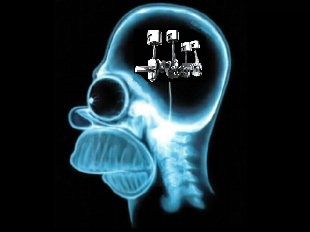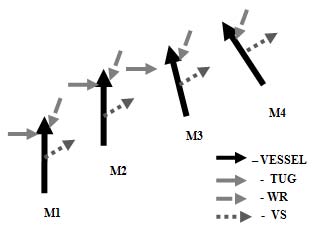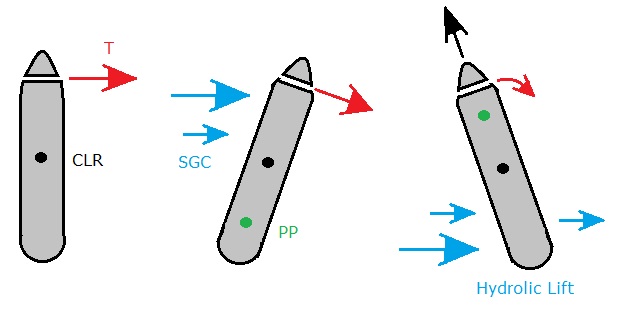ok we got to a tunnel how about whats in it, FPP CPP or CPP and variable speed?
You should have the thruster data on board from the NA on the thrust created at what speed but that doesnt answer the damage question.
[QUOTE=Topsail;131947]
But just forget it if it seems for you coming from outer space.[/QUOTE]
It appears you have been reading a few bow thruster interaction studies but are totally incapable of understanding what they say.
Rather than act like a complete ass, how about provide a single quote from any published study of bow thruster and hull interaction that states the bow will be “diverted in the opposite selected direction.”
There are plenty of pretty diagrams showing how a less than competent boat driver or pilot can move the ship sideways opposite the direction he thought it should go but anyone with a modicum of reading comprehension skills can easily see that it is not caused by the thruster acting opposite to the selected direction of thrust. Worst case for the thruster is no thrust.
You made the claim, you couldn’t back it up the first time and now seem to think that trashing me because I am an engineer will divert attention away from that claim - it’s up to you to prove it now. So far all you have shown is you have reading comprehension problems and don’t like being shown up as a fool by a mere mechanic.
[QUOTE=powerabout;131976]ok we got to a tunnel how about whats in it, FPP CPP or CPP and variable speed?
You should have the thruster data on board from the NA on the thrust created at what speed but that doesnt answer the damage question.[/QUOTE]
Which one do you know the answer to? Pick one.
We have a Brunvoll transverse thruster powered by a Marelli 910kw motor, out of the manufacture manual, Do not operate at full thrust over 6 knots due to possible overload
We have a Brunvoll retractable thruster powered by a Marelli 800kw motor, out of the manufacture manual, Do not drop above 6 knots, not to exceed 8 knots with 360* rotation and speed up to 14 knots with +/- 35* rotation.
[QUOTE=Steamer;131978]You made the claim, you couldn’t back it up the first time and now seem to think that trashing me because I am an engineer will divert attention away from that claim - it’s up to you to prove it now. So far all you have shown is you have reading comprehension problems and don’t like being shown up as a fool by a mere mechanic.[/QUOTE]
IIRC, Topsail claims to be a Pilot and this brings an old joke to mind. What is the Difference between a Ship Pilot and GOD? Answer, GOD knows he’s not a Pilot.
Some guys will never get it through their head that the Engineers keep the ship moving and and all that they do is keep her pointed in the correct direction.
[QUOTE=chefedemaquina;131991]We have a Brunvoll transverse thruster powered by a Marelli 910kw motor, out of the manufacture manual, Do not operate at full thrust over 6 knots due to possible overload
We have a Brunvoll retractable thruster powered by a Marelli 800kw motor, out of the manufacture manual, Do not drop above 6 knots, not to exceed 8 knots with 360* rotation and speed up to 14 knots with +/- 35* rotation.[/QUOTE]
“Possible overload” I am going to guess that the ans to the OP is that running the thruster with increased ship’s speed creates turbulence inside the tunnel which risks either overload or a too short load/unload cycle.
[QUOTE=Tugs;131997]IIRC, Topsail claims to be a Pilot and this brings an old joke to mind. What is the Difference between a Ship Pilot and GOD? Answer, GOD knows he’s not a Pilot.
Some guys will never get it through their head that the Engineers keep the ship moving and and all that they do is keep her pointed in the correct direction.[/QUOTE]
Do you know why pilots will be seated next to God in the heaven, it’s because they’re the ones who prayed the most during their career to have save the adventure from … main engine shut down, electrical black outs, generator failure, bow thruster shut down, rudder breakdown, failure of lubricating oil pumps, incapacity to start, reverse or stop the main engine, inability to bypass the computer load control, improper maintenance, malfunctioning of mooring winches & windlasses & gangway lifting motors, incapability to prevent situation from getting worse after repairs, pollution from magic pipes, 4th of July sparks coming out from stack, black smoke, non flushing toilets and shit smell all over the ship !
And now you will show to a 20 years harbor pilot how to use a bow thruster with caution … yeah right ! 
When an oiler has chat for too long with a piston engine, he finishes by taking same judgment habits !

[QUOTE=Topsail;132040]And now you will show to a 20 years harbor pilot how to use a bow thruster with caution … yeah right ! [/QUOTE]
Well Mr. Pilot, it looks like you are well and truly aground. Still can’t find a chart for Bow Thruster Shoal, eh?
Instead of wasting time looking for silly graphics, you should have been studying those drawings of ships going sideways into the opposite bank because Mr. Pilot thought he knew how to dock a ship. blaming it on the bow thruster just makes you look like an idiot. Have you noticed the huge number of experienced ship handlers jumping in here with tales of thrusting left, moving right and how it ruined their day? If your performance here is an example of what you bring to the wheelhouse, I hope your victims have tugs at the ready.
Steamer, you did not like your head x-ray graphic ? I tough it looked pretty realistic to me, no ! I also wonder why there is no other pilot that I know of, who shows up on this exceedingly professional august forum to share knowledge and experiences. They probably have no time to loose with crankcase assisted brain.
Lateral Resistance vs. Peripatetic Pivot Point is a brand new finding. Just like the Radar and ECDIS that no one believed in when where introduced, however by today’s standards became indispensables and essentials. Lateral Resistance phenomenon reconsider deep anchored pivot point myth and gives a full updated and modern explanation to some of the unpredictable and enigmatic ship handling behaviors. From now on, all manned model ship handling facilities will also have to reconsider their program. I know that one of the best facility in Grenoble, France, has already adhered to and followed footsteps. Give them a phone call. But like I said from my own experience, nautical academy scholarship ceases where piloting starts. I have the regret to say that God’s nor manned model ship handling facilities, will scattered sacred secrets on the web. Uno momento por favor amigo, you will whether have to be trained by an erudite senior pilot or pay up to $2,000.00us a day to be lectured in a ship handling facility on that matter. But one day, it will be agreed upon and diffuse at large.
My dear piston assisted colleague, I have over 2,000 ships manoeuvres in my collection on vessels up to 1,000ft in length, without a single accident report owing by my own accountability. I will not asking you how many manoeuvres you have in yours so to be such a repute ship handler, because you unfortunately did not choose the correct department. When I deduce or whether smell … that the engine is run by a Chief of your utmost quality, I always request a minimum of at least two (2) 60 tons bollard pull z-drive tugs. On few occasions, I used 3 of those !
Again, [I]“In the discharge mouth area of a bow thruster, the pushing force generates a water flow acceleration that produce a pressure differential (vacuum) which combined to the lateral resistance pressure summation along either side of a moving ahead vessel, could divert the bow in the opposite selected direction while the rudder remains amidships. The same phenomenon can occur with a pushing tug.”[/I]
Signed and no bad feeling. 
But … don’t get me wrong here. I have an extensive sea experience but on no occasion, have I had an argument with an engineer. On the contrary, I always got well along with these species. Going ashore with my body from the engine room. Taking real good care of ER Fire Fighting Equipment. Doing all kinds of repairs in the ER Workshop. My wife been invited by the CE to do an ER tour, which I kept a close eye on it ! Being invited myself as a pilot to visit the ER in the company of the Chief. Having real good and interesting chats with the CE on the bridge. As a captain, I ounce called the Chief to have a talk … to discover that I was inviting him for a good Chivas Regal 20 years of age shot, on a dry ship ! I really like mechanics. I have the utmost respect for these guys.
But never in my hole carrier a Chief like Steamer told me ; "[U]Humor me [/U]and provide a bit more information … " That is a real lack of class, dignity and diplomacy.
No hard feeling again.
[QUOTE=Topsail;132081]Lots of egotistical crap deleted …
Again, [I]“In the discharge mouth area of a bow thruster, the pushing force generates a water flow acceleration that produce a pressure differential (vacuum) which combined to the lateral resistance pressure summation along either side of a moving ahead vessel, could divert the bow in the opposite selected direction while the rudder remains amidships. The same phenomenon can occur with a pushing tug.”[/I][/quote]
You seem to have neglected to include the statement that the net force is diminished, not moved into the negative side. I’m still waiting (but not for long as you have become boring) for a citation from any legitimate naval architectural or marine engineering text or paper supporting your statement that at or around 4 knots, the bow thruster will push the bow in the opposite direction to that selected.
There are about a zillion ship and tunnel thruster equipped boat handlers on this site, if such were the case then surely one of them would have come to your rescue with a tale of how his day was spoiled or nearly so by your elusive phenomenon.
It just won’t stay dead though … I knew that some pilots think they are Gods but I didn’t think they were capable of resurrection.
IMHO the risk is on a fixed speed cpp tunnel is the blades will crash back and forward ( pitch wise) when there is no load in a cavitation situation like the water cant get into the tunnel at high speed hence the warnings
[QUOTE=powerabout;132131]IMHO the risk is on a fixed speed cpp tunnel is the blades will crash back and forward ( pitch wise) when there is no load in a cavitation situations…[/QUOTE]
If the drive is fixed speed (an AC motor for example) when cavitation or ventilation occurs, the load on the drive train will vary, not the speed. The blade angle is essentially fixed by the pitch change mechanism and except in the case of a constant speed propeller, the shaft rpm or prop pitch will not change.
The risk of the condition you describe is the rapid and extreme changes in load that can damage gearing and bearings.
I see that the ship handling guru has been supported by some piston assisted disciples. Good for you. 
Many of you will recall Pilot Hugues Cauvier’s excellent article on the pivot point in the October 2008 issue of The Pilot. Paul Butusina’s article covers much the same ground but due to the importance to pilots of understanding this elusive point I felt that it was well worth revisiting the topic. The aim of this paper is to[U] add few corrections to the pivot point theory as it is presented in seafarers books[/U], because understanding the pivot point is such an important element of safe manoeuvring of the vessel.
http://www.pilotmag.co.uk/wp-content/uploads/2012/01/Pivot-point-web.pdf
[B]The Donkey Effect[/B]
One of the most spectacular examples of applying an external force upon a vessel and[U] getting the opposite result to that expected /U is the movement of the vessel when a tug is acting on the support of water resistance force against it (Fig12).

If the tug starts to push on a vessel moving at speed in position M1 it cannot turn the vessel due to the short turning lever. She will drift to starboard but will maintain the heading as in position M2. As soon as the tug stops pushing in position M3, the vessel will start to turn towards the tug. She will continue to turn in that direction as is shown in position M4 until the forces stabilise and the heading stability is restored.
In real time trials with escort tugs this effect has also been observed when the tug stays pushing on the hull. This effect along with those explained in Fig 9 are most important for pilots using tugs on a vessel making way through the water. The higher the speed the more pronounced the effect.
Same Donkey Effect when using the bow thruster while the vessel is moved ahead …

I read the entire PDF linked. It did not seem likely a bow thruster would produce any significant force the “wrong way”, more like it would have a net result of about nothing if used above a certain speed. There are other issues with a ship moving in and out of a self-created sideways pushing current that could come into play*, but they would also apply to a tug or anything else with a sideways pull. Back when I sold and installed bow thrusters, the dealer classes we went to for installation and use just warned us they would not work with much way on or a strong current running past the vessel at the 'wrong" angle.
- this was very interesting reading. This is not a significant factor for size the vessels I have been on. Sailing vessels with modern keels also don’t suffer from the wandering pivot point isssue. Makes life easier

[QUOTE=Topsail;132153][B]The Donkey Effect[/B][/QUOTE]
The Donkey Effect is certainly in play on this thread. I suppose it was bound to happen once the horse was beaten to death.
[QUOTE=yacht_sailor;132154]I read the entire PDF linked. It did not seem likely a bow thruster would produce any significant force the “wrong way”, more like it would have a net result of about nothing if used above a certain speed.[/QUOTE]
Yes, but Topsail was not asked to show written proof that the forces would be strong enough to veer the ship the wrong way, only to explain the physics of the phenomena, which he did. If he observed a a ship of a certain size at about 4 kts veering off the wrong way it seems plausible that this would be the explanation.
